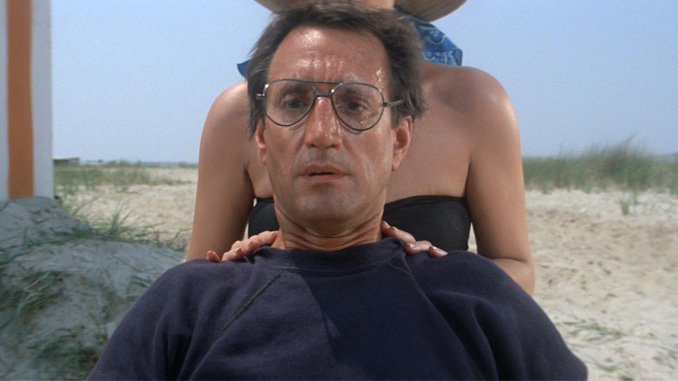
Jaws…
What can old Shady say about the big fish that hasn’t already been said? Well, here’s one thing that’s always struck me about Steven Spielberg’s 1975 classic. For a movie that’s all about a monstrously oversized, great-white man-eater, Jaws rarely shows us much shark. In fact, we don’t even get a full shot of that ominous fin rising from the water until 1 hour and 2 minutes into the film’s full 2 hours and change. So, why not show us more hot, fishy action?
I know that the film crew had problems with the mechanical shark, but much of the movie’s power lies in its capacity to deny us what we want to see, to deny us a clear view of those horrifying jaws ripping human bodies limb from bloody limb.
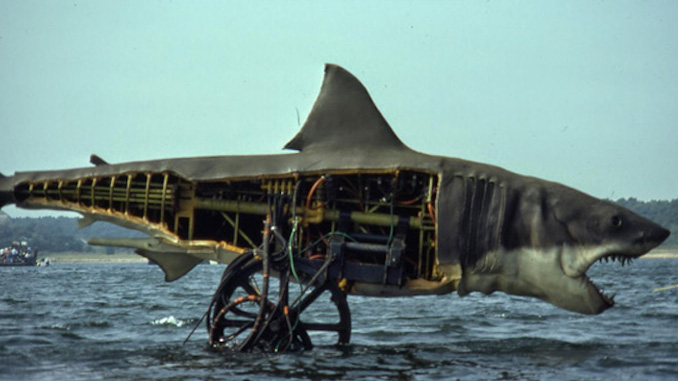
Sure, we see loads of bloody limbs throughout Jaws. But, generally speaking, they’ve already been severed by the time we get a peek at them. It’s sort of a paradox, really. The film makes us desperate. We crave the appearance and savagery of the shark at the same time that we’ve learned to be terrified by its arrival.
Of course, Jaws remains a noteworthy film for any number of reasons. To begin with, it was the first summer blockbuster. That’s right. You can blame that big-ass fish for all the bloaty-budget summer movies that come along to chew up all the box office receipts. Oh, and let’s not forget that John Williams’ brilliantly minimalist score for Jaws has continued to tingle spines for over 40 years now. Then there’s Bill Butler’s dynamic cinematography filling every sequence of the film with movement and energy, and Verna Fields’ precision editing, which keeps the movie speeding along on its suspenseful and dramatic course. And… blahdy-fucking-blah.
I mean, it’s all true, of course. Jaws has all those things going for it, but that’s not why we’re here. Let’s be honest, when we talk about why Jaws has become such a touchstone of horror cinema, we’re also telling the story of how Steven Spielberg became one of the most important directors in film history, right?
Critics love to talk about how Spielberg went from making TV thrillers like Duel and popcorn flicks like Raiders of the Lost Ark and Jaws in the ‘70s and ‘80s to more ambitious fare like Schindler’s List and Saving Private Ryan in the ‘90s. Let them talk. For my money, Jaws represents Spielberg at his best.
In fact, I’ll go a step further. In his mag-fucking-nificent biography of Alfred Hitchcock, The Dark Side of Genius, Donald Spoto tells us that “Hitchcock liked the phrase pure cinema–‘this is pure cinema.’ What he seems to have meant by that was that he wanted to use as often as possible strictly visual means, not dialogue, to get across the emotional impact, the feeling of a shot or a sequence.” Hitchcock generally described “Pure Cinema” in the same way that boring AF film scholars describe the Kuleshov Effect. Simply put, cinema viewers find two sequential shots more meaningful than a single shot on its own. I know! You’re shocked, right? Now, let me show you how Spielberg uses Pure Cinematics in Jaws to rev up everyone’s internal fear motor. The most famous use is probably here:
The shot, which cuts away from Brody chumming the waters to him standing back and pulling one of his patented “What the Shit!?” faces communicates far more than any dialogue could (even though it’s punctuated by the most famous line of dialogue in the movie).
But the opening shots of the film — which juxtapose overhead images of young swimmer Chrissy as she heads out into the water at night with the contrasting underwater images of the Shark’s POV — stand out to me as providing some of the film’s most terrifying moments.
By the Master of Suspense’s own definition, Jaws constitutes a work of pure cinema. That is, with the exception of one very noteworthy sequence, Jaws hardly needs any dialogue to achieve its horrifying effects.
What I’m suggesting is that Jaws operates like a Hitchcock film turned up way the fuck past eleven. For that reason alone, I think it represents Spielberg at his absolute, undiluted best. And just so you don’t think that this is all about intellectual arguments, let me make something clear. When I first saw it back in 1975, Jaws scared the flying fucking shit out of me. In fact, I didn’t go back in the ocean to swim until 2007.
Like Hitchcock, Spielberg makes us want something (in this case the emergence and clear view of the shark) at the same time that he keeps refusing to deliver that very thing. By manipulating this desire, by denying us the pleasure that we so desperately seek, Spielberg makes the movie about tension and anxiety rather than merely about jump-scares and chowing down on defenseless swimmers.
Brilliant horror filmmakers, from Robert Weine and Tod Browning to John Carpenter and David Cronenberg, all seem to have grasped this fundamental principle: if you make an audience desire a thing and then continually defer the appearance of that thing, the audience will experience a metric fuck-ton of anxiety. What’s more, they’ll start to enjoy the experience of anxiety itself. I know that it’s fucked up, but that’s how horror works.
Now, I hear your arguments. What about the last third of the movie? We see a lot of the shark, then, right? Well, sort of. We do get fuller images of the shark.
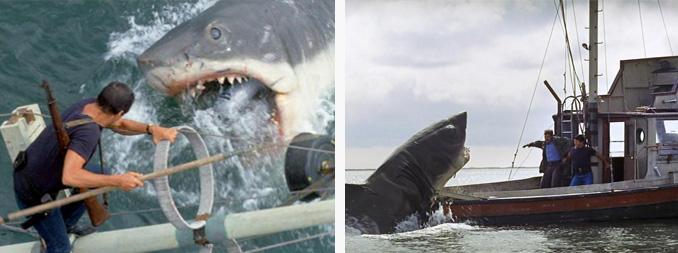
Once Brody heads out to sea to hunt the monster alongside Captain Quint (played with scene-chewing misanthropy by Robert Shaw) and oceanographer Matt Hooper (played by Richard Dreyfuss), the movie changes course. Now, it’s not a suspense-based monster movie so much as a Jack London-style, men vs. nature adventure film. But even with the epic cat and mouse chase sequences, even with tough man Quint facing off against the vicious-as-fuck shark, Spielberg still finds a way to slow the film down and manipulate us with a quiet, anxiety-drenched, suspenseful scene. In the midst of a series of rather intense chase sequences, the three shark hunters sit below decks sharing drinks and stories on The Orca, Quint’s slightly too-small fishing boat.
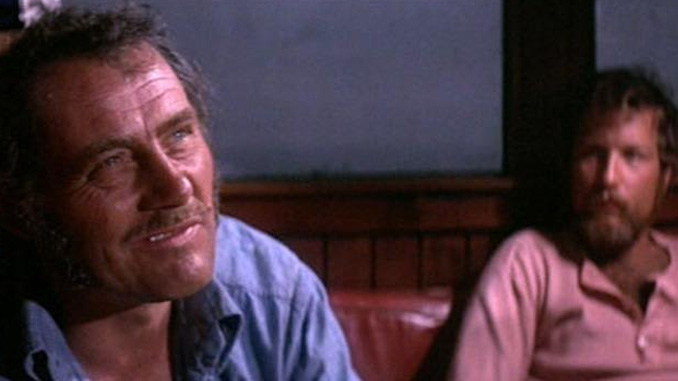
After the men compare scars (literally), Quint delivers an emotionally charged tale describing how he survived the sinking of the U.S.S. Indianapolis in shark-infested waters. The scene is a compelling one, in part because the audience begins to sense that this big man who knows no fear once experienced a terror beyond all reckoning. The scene counts as one of the signature monologues of ‘70s cinema. In fact, Shaw’s storytelling seems so vivid that you feel as though you’ve actually seen the incidents he’s described. Once again, the film has taken the shark away only to make us fear it all the more. This time, rather than using Pure Cinema, it uses dialogue. When Bruce the shark pops up again at the very end of the Indianapolis scene, he signals the arrival of the movie’s blood-soaked climax. Quint will face abject terror one more time.
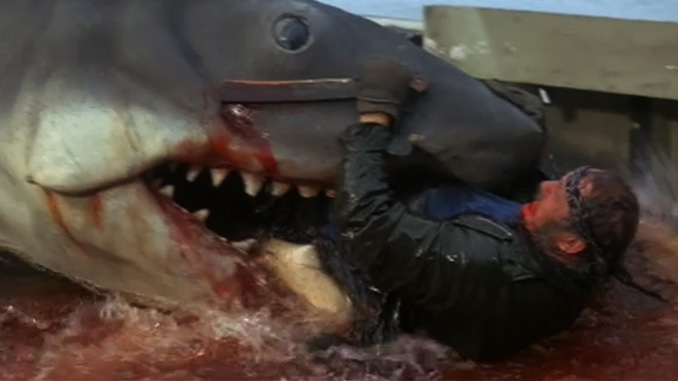
As far as I’m concerned, Spielberg does his best work when he’s using the techniques he’s learned from older films. He’s brilliant at taking apart and rebuilding genre. He’s a master of perfect sight-lines, of crisp shot/reverse shot dialogue, of judiciously deployed special-effects, of carefully choreographed action. Jaws showcases the talent of a young filmmaker at the absolute top of his game, and it remains a masterpiece and landmark in cinema history because it worries about its mostly unseen shark and never about its own artistic merits.

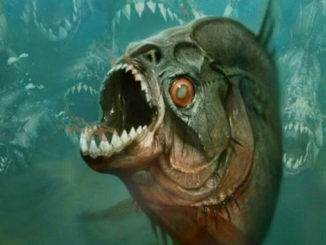
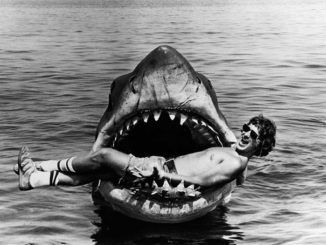
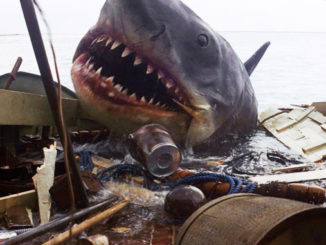
Fuck a bunch of Raiders and Schindlers and Ryans . . . Jaws is Spielberg’s opus, period.
@ BJ McFrisky: I dig moments in all of those other movies, of course, but i prefer my Spielberg undiluted by artistic pretension. To me, the later films feel a bit like drinking really good, single-malt scotch with a bunch of ice and water. I don’t need ice or water in my whiskey, and I don’t need my pulp-filmmakers to crave artistic credibility.
I’ve got a long and detailed riposte to this. Would you like to read it? How should I deliver it? Email, here? A FB message seems inadequate.
yep